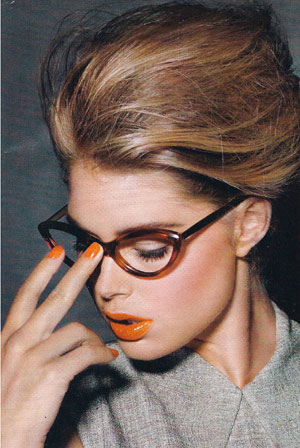
|
Four-in-hand knots go with just about every shirt collar.
These are just a few of the fashion truisms that help guide the aesthetically conscious through everyday life: Rules of thumb we've learned through experience, trial and error, fashion magazine columns, and daytime talk television on sick days. Seeing as how glasses are a relatively new fashion phenomenon, however, the optical field is largely bereft of such guideposts. There are countless charts online showing various face shapes and offering frame guidance, but most of these originated in the cosmetology field; they were designed to help hairdressers determine the best haircut for a woman's face shape. At best, they've been haphazardly applied in optics: For one, the charts were all originally designed with women's faces in mind, and what women would like to accomplish aesthetically often differs greatly for men. For another, advice from the world of cosmetology does not always have a one-to-one translation into the world of opticianry, as solid as the link between the two may be.
Just because no one's bothered to sit down and articulate any across-the-board "rules" doesn't mean that manufacturers haven't been following them for years, though. In fact, manufacturers have, by and large, followed a pair of general guidelines for quite some time when it comes to men's and women's frames; they just haven't been advertising it.
 |
|
Source: L'Oreal Elnett Ad |
Take a look at the women's frames in your dispensary, and you'll notice that a large number of them have some sort of temporal upturn that slowly tapers off as it nears the nasal. Some will be more subtle than others; at its' most extreme, this design becomes the classic cateye, with corners so sharp you could edge lenses with them (or at least make yourself a nice pair of uncuts). What you'll probably notice is a dearth of frames that either turn down at the corners or have a straight line running across the top. Go ahead and look; I'll wait. I haven't eaten for a while anyway.
OK, back? I enjoyed my tuna; did you see what I was talking about? Yes? On the same page? Let's go on.
Most frames are designed with a Western European and American consumer in mind, so the psychology of Americans and Western Europeans are taken into account when designing frames. As a whole, men and women are psychologically predisposed to find women more pleasant and/or appealing when they are smiling; in fact, a study published in a 2008 edition of the Journal of Social, Evolutionary, and Culture Psychology found that smiling women are perceived of as more intelligent, happier, and more trustworthy. Additionally, studies in which men were asked to rate photos of women based on their attractiveness have consistently demonstrated that men will rate photos of the same woman higher if she is smiling than if she has a neutral or sullen expression. What does this have to do with frames? Take another look at the shape formed by that upswoop. Try and replicate it on a piece of paper.
It's a smile.
When a woman wears a frame with an upswoop, the raised corners of the frame draw the eye up to these points, creating an optical illusion in which the woman's features appear to be raised as well. That old, sharp, "grandma" cateye then is, really, the ultimate accessory for women—something that, subconsciously, enhances the very aspect of femininity itself. Along with the "smile" of the frame, the overall effect is to create a constant appearance of happiness and well being by maintaining a consistent, subliminal "smile"—thus rendering the wearer perpetually "desirable" to look at. This explains the lack of downturned frames, which would create a sagging, sad, morose look for the wearer by drawing her features downwards. (Fun fact: Similar studies have found that women who appear to be sad are perceived of as vulnerable and therefore emotionally weak, and tend to attract the wrong sort of attention). It also explains the dearth of straight-edged frames, which brings us to...
 |
|
Justin Timberlake wearing Ray Wayfarer eyeglasses.
|
While many of your women's frames will feature the upswoop, many of your men's frames will have a straight or relatively straight top to them. At its most extreme, this is a completely horizontal line that, dependent on its' position on the wearer's face, creates an almost unibrow effect. Why?
It turns out that, while smiling may make women appear more desirable, it makes men appear... feminine? Strange as it sounds, when researchers at the University of British Columbia asked men and women to assign different traits to photos of men with various facial expressions, respondents rated smiling men as less physically attractive, less desirable, and more feminine than when those same men were pictured with angry or neutral expressions. As it turns out, we tend to perceive of men at their most attractive when they appear the most dominant—and stern, angry, or neutral expressions appear more dominant than smiles, which indicate friendliness and passiveness. (Consider for a moment how many action stars or romantic leads are pictured on movie posters smiling, vs. sullen, brooding expressions).
In the same way that upturned frames serve to create the illusion of a perpetual smile, straight-edged frames for men create a sort of perpetual scowl—not a mean face, per se, but one that speaks to a certain consternation with existence itself. The face of someone always ready to meet a challenge because he sees life as a challenge. Think John Wayne. Think Clint Eastwood. Think Humphrey Bogart. These were to-the-wall, whole-hog, butt-kicking tough guys who could chew up and spit out whatever came across their path... and they always looked a little teed-off. Straight-edged glasses give a man that look: The look that says, "Look out."
There are no golden rules to fashion that will give someone an eternally perfect look, and there's no accounting for the myriad variations in people's face shapes, sizes, proportions, and skin tones. Using the above rules of thumb, though, can help as a basic foundation for helping your patients choose the frames that will suit them best. And, maybe, get them a date next Friday night.













